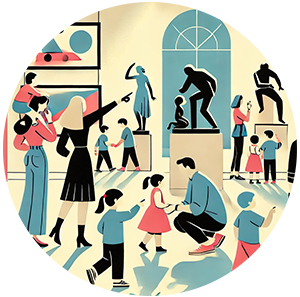New York City is one of the world’s most culturally diverse cities, and Spanish speakers form one of its largest and most influential communities. Nearly 2.5 million NYC residents speak Spanish at home, and millions of Spanish-speaking tourists from Latin America and Spain visit the city each year.
For museums, theaters, and cultural institutions, this presents a huge opportunity—yet many fail to fully tap into Spanish-language marketing, digital engagement, and outreach. Here’s why now is the time to strengthen your Spanish-language digital strategy:
High-Spending Spanish-Speaking Tourists – Visitors from Mexico, Spain, Colombia, and Argentina contribute billions to NYC’s economy, but without targeted SEO, bilingual content, and localized marketing, cultural venues are missing out.
4 Strategies to Engage NYC’s Spanish-Speaking Audiences
1. SEO & Localized Content – Make Your Institution Discoverable
- Bilingual Website Optimization – Ensure your exhibits, events, and programs rank on Google searches in Spanish.
- Spanish-Language Blogs & Articles – Publish content highlighting Latino artists, cultural exhibits, and historical contributions.
- Google My Business (GMB) in Spanish – Optimize Google listings to attract Spanish-speaking tourists.
2. Bilingual Social Media Marketing – Meet Audiences Where They Are
- Create Spanish-Language Content – Use Spanish captions, hashtags (#CulturaNYC, #ArteLatino) and bilingual posts.
- Launch Targeted Facebook & Instagram Ads – Promote cultural events & exhibits to Spanish-speaking users in NYC and overseas.
- Engage in Real-Time – Use WhatsApp Business for customer service and Q&A in Spanish.
3. Spanish-Language Email Marketing & Community Outreach
- Bilingual Email Newsletters – Send Spanish-language updates on events, artist talks, and exclusive experiences.
- Partner with Hispanic Community Centers & Schools – Connect with Spanish-speaking families & students for educational outreach.
- Offer Membership Benefits in Spanish – Highlight special offers for Spanish-speaking visitors and their families.
4. Promote Culturally Relevant Exhibits & Events
- Feature Latino Artists & Cultural Figures – Celebrate Hispanic Heritage Month, Día de los Muertos, and other key Latino cultural moments.
- Offer Spanish-Language Guided Tours – Provide audio guides, in-person tours, and digital storytelling in Spanish.
- Create Events That Reflect Latino Culture – Host panel discussions, artist showcases, and food & music experiences.

How Eyestorm Helps Cultural Institutions Engage Spanish-Speaking Audiences
At Eyestorm, we specialize in content-driven marketing and inbound strategies powered by HubSpot, helping museums, theaters, and cultural institutions engage NYC’s Spanish-speaking community and attract Spanish-speaking tourists.
- Bilingual SEO & Content Marketing – Optimize your website, blog, and event pages to rank in both English & Spanish.
- Social Media & Influencer Partnerships – Connect with Hispanic influencers, creators, and digital communities.
- Targeted Multicultural Campaigns – Develop bilingual ad strategies to reach the right audiences.
Let’s make your institution more inclusive & accessible. Schedule a consultation today!
Stay Connected with Food & Culture Tidbits – Subscribe to Our Newsletter!



Comments